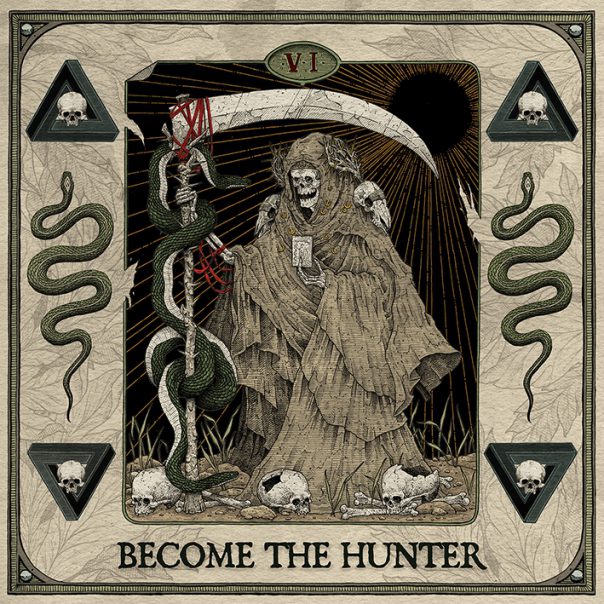ALBUM REVIEW: Suicide Silence bites the bullet to ‘Become The Hunter’

Breaking deathcore into its melo-death beginnings (2000s), its brutalization (late 2000s and early 2010s) and its recent nu-metal crossover reveals Suicide Silence at the forefront of the latter two eras. The Riverside band’s initial run brought the genre away from At The Gates and toward Cannibal Corpse, and had just begun resurrecting Korn riffs leading up to Mitch Lucker’s untimely death.
Become The Hunter
Suicide Silence
Nuclear Blast Records, Feb. 14
With Hernan “Eddie” Hermida of All Shall Perish as the new vocalist, Suicide Silence further embraced the nu school. This culminated in 2017 with the polarizing, controversial and decidedly lackluster self-titled album.
Suicide Silence presents Become The Hunter as proof it can still write solid heavy music. More than a hapless return to form, the album exudes infectious rage.
It’s wonderful to hear instrumental intro “Meltdown” sounding like deathcore should: angular, sinister and hard-grooving.
Nu metalish beats remain central to the band’s sound, as “Two Steps” exemplifies with rhythm guitarist Chris Garza’s syncopated chugs. The difference this time is the prevalence of tremolo picking and guitar solos by lead guitarist Mark Heylmun, Alex Lopez’s blast-beat double-bass drumming and Hermida’s vocals that range from banshee-like shrieks to grizzly growls (and everything in between). The brutality is back, all without breaking ties from nu-metal.
The fact Jared Dines—who popularized the “Tee-Hee” meme that will always haunt unfortunate 2017 single “Doris”—has a cameo in the video for “Feel Alive” speaks volumes of Suicide Silence’s mindset during this album cycle. Rather than double down or apologize, the band just focuses on playing well and playing hard. Jackhammer bomb blasts, sludgy chugs and hammered riffing defines “Love Me To Death,” which showcases the highest recesses of Hermida’s screaming. The riffs, while heavy, are audibly thoughtful.
There’s some definite dynamism to this album’s sound, most notably on the atmospheric “Skin Tight.” Hermida’s screams cut through the ominous clean guitar tones with ease, bookended by classic deathcore breakdowns. The jumps from soft to loud are visceral and cathartic, especially the switch from bludgeoning fight riffs to grand melodic passages toward the end.
Hammered guitar notes drive the bulk of “The Scythe,” juxtaposing Suicide Silence’s nu-metal bounce rhythms with its savage death metal element. Both of these songs are prime examples of simplicity and ambitiousness complementing each other, with Hermida pulling off the angsty nu-metal vocal crescendo with compelling intent.
Listening to cuts like “In Hiding” and “Death’s Anxiety” essentially sound like the self-titled album—taking out cringeworthy singing and over-simplified riffs and reintroducing the brutal death machismo that Suicide Silence pops off in the first place. Both tracks balance an extreme and a groovy approach, with guitar and drums locking into some riveting rhythmic evisceration.
Hermida’s vocals shine on these deeper cuts, using vomited gutturals and rabid snarls to emphasize the brutality as much as possible. Much like Lucker did back in the day, Hermida is able to command emotion and the urge to mosh and head-bang. His notes are well-planned and well-executed, just like every aspect of this album. His constant shifts in tone and register keep more straightforward cuts like “Serene Obscene” interesting, at least after the ambient sitar intro draws you in.
The unrelenting thrasher “Disaster Valley” does a good job of contrasting lurching caveman riffs with more acrobatic playing, as does the concluding title track. The latter features some of the more intensely technical arrangements on the album.
The final breakdown on the album doesn’t reinvent the wheel, but its layered screams and bludgeoning tempo shifts capture the crushing grit that gave rise to Suicide Silence as a cultural force. While many of the album’s ideas aren’t overly complicated or overbearing, they do exactly what’s required for an awesome slab of mosh-worthy metal. In a time where deathcore is evolving and growing at a rapid pace, it’s encouraging to see one of the genre’s seminal bands rediscover its roots with a forward-thinking spirit.
Follow Max Heilman at Twitter.com/madmaxx1995 and Instagram.com/maxlikessound.
